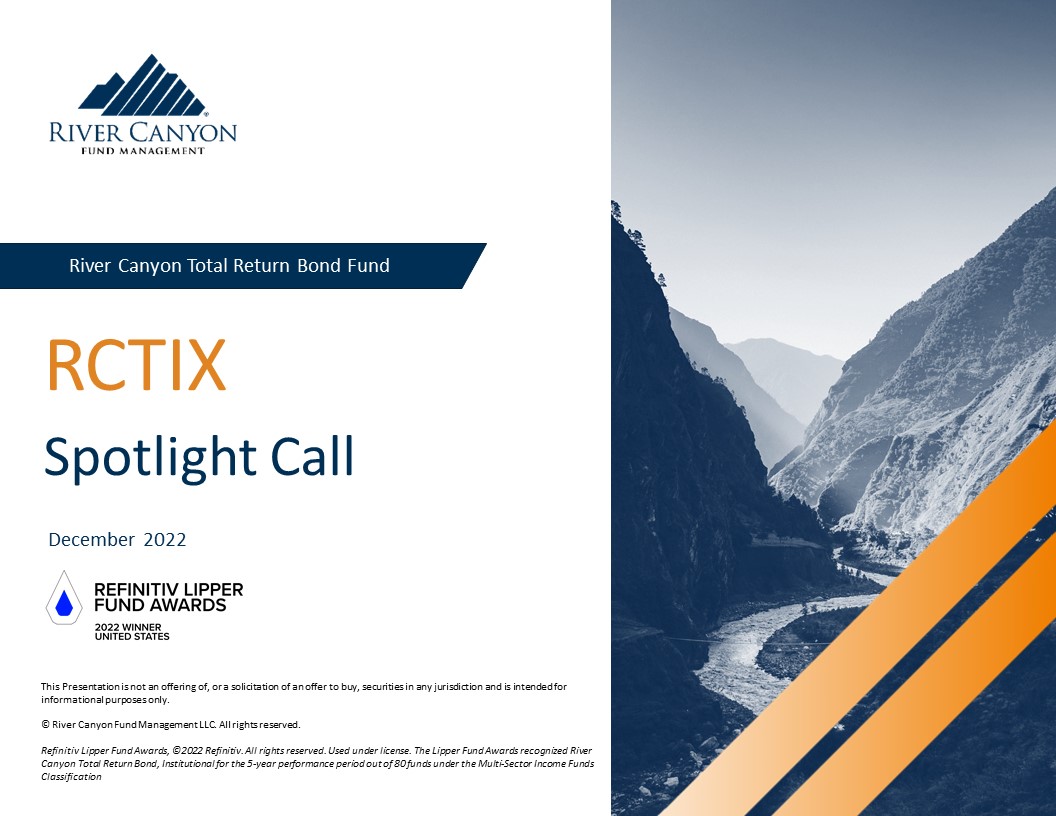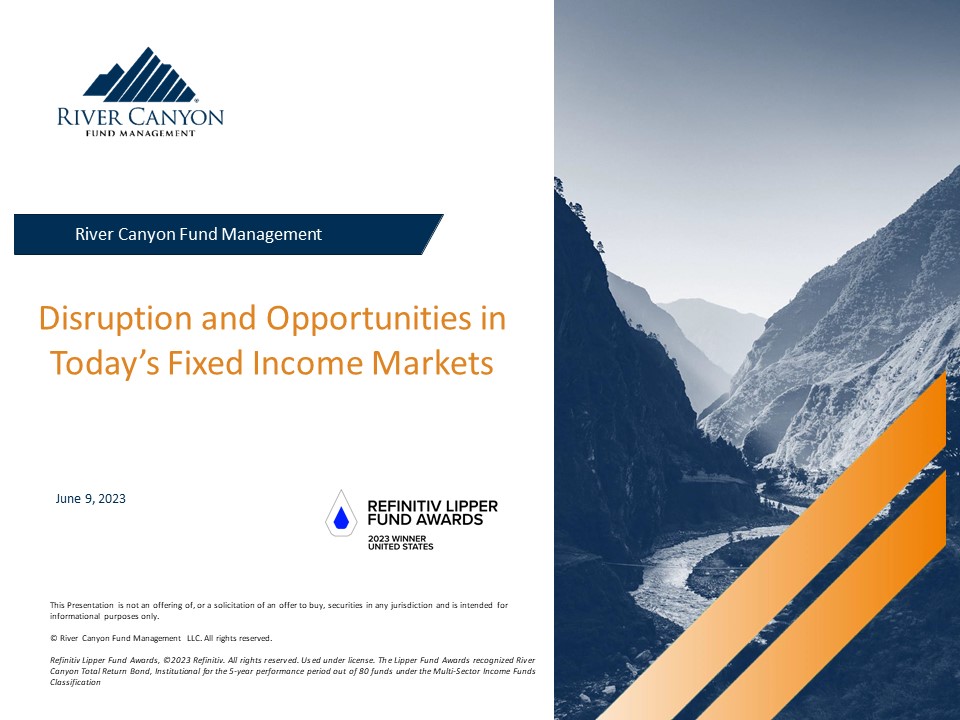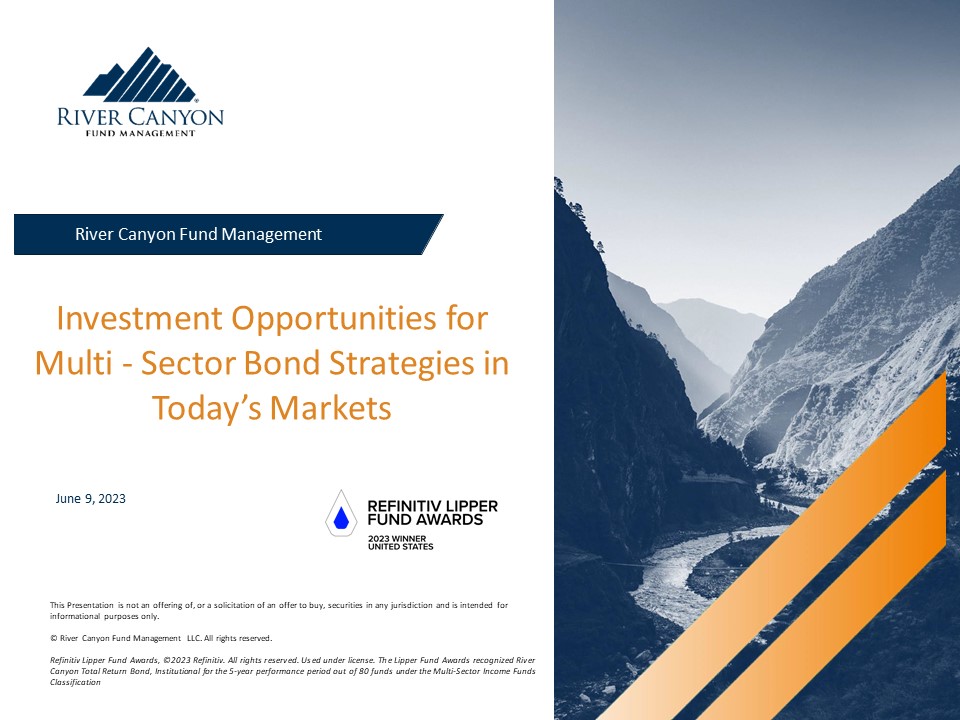Insights
Disclosures
Investors should consider the investment objectives, risks, charges and expenses of the fund carefully before investing. This and other information are contained in the fund’s prospectus, linked here, and statement of additional information, which may be obtained by contacting River Canyon or calling 1-800-245-0371. Please read these documents carefully before you invest or send money.
The performance data quoted represents past performance and is no guarantee of future results. Investment return and principal value of an investment will fluctuate so that an investor’s shares, when redeemed, may be worth more or less than their original cost. Current performance may be lower or higher than the performance data quoted. For the most recent month-end performance, please call 214-253-6600.
Please see the link to standard performance and 30-day SEC yield for the River Canyon Total Return Bond Fund: https://rivercanyonfunds.com/total-return-bond/
Please click here for holdings. Holdings are subject to change at anytime.
Any investment in the fund involves significant risk, including the risk of loss of all or a portion of your investment. Certain information contained herein constitutes “forward-looking statements”, which can be identified by the use of forward-looking terminology such as “may,” “will,” “should,” “expect,” “anticipate,” “target,” “project,” “estimate,” “intend,” “continue,” or “believe,” or the negatives thereof, or other variations thereon, or comparable terminology. Due to various risks and uncertainties, actual events or results, or the actual performance of an individual investment, an asset class or the fund may differ materially from those reflected or contemplated in such forward-looking statements. Past performance is not indicative of future results. It is important to note that the fund is not guaranteed by the U.S. Government. Fixed income investments involve interest rate risk, issuer credit risk, prepayment risk, duration risk, price volatility risk, and risk of default. Funds investing in bonds can lose their value as interest rates rise, and investors participating in such funds can suffer a partial or total loss of their principal. More details regarding these risks are contained in the fund’s prospectus and statement of additional information. Mortgage Backed Securities (“MBS”) and other asset-backed securities involve risks that are different from or more acute than risks associated with other types of debt instruments. For example, rising interest rates tend to extend the duration of fixed-rate Mortgage Backed Securities, making them more sensitive to changes in interest rates and causing funds investing in such securities (such as this fund) to exhibit additional volatility. Conversely, declining interest rates may cause borrowers to pay off their mortgages sooner than expected, thereby reducing returns because the fund may be required to reinvest the return of borrower principal at the lower prevailing interest rate. Mortgage Backed Securities related to floating rate loans may exhibit greater price volatility than a fixed rate obligation of similar credit quality. With respect to non-agency Mortgage Backed Securities, there are no direct or indirect government or agency guarantees of payments in pools created by non-governmental issuers. Non-agency Mortgage Backed Securities also are not subject to the same underwriting requirements for the underlying mortgages that are applicable to those mortgage-related securities that have a government or government-sponsored entity guarantee.
Basis Points are a unit of measure used in finance to describe the percentage change in the value of a financial instrument. One basis point is equivalent to 0.01%(1/100th of a percent).
Duration is a calculation of the average life of a bond (or portfolio of bonds) that is a useful measure of the bond’s price sensitivity to interest rate changes.
Bloomberg US Aggregate Bond Index (“The Agg”): The index is an unmanaged index that measures the investment grade, US dollar-denominated, fixed-rate taxable bond market. The index includes Treasuries, government-related and corporate securities, mortgage passthrough securities, and asset-backed securities. It is not possible to invest directly in an index.
Bloomberg US Corporate High Yield Bond Index: The Index measures the USD-denominated, high yield, fixed-rate corporate bond market. Securities are classified as high yield if the middle rating of Moody’s, Fitch and S&P is Ba1/BB+/BB+ or below. Bonds from issuers with an emerging markets country of risk, based on Bloomberg EM country definition, are excluded.
B of A MOVE Index The MOVE Index measures U.S. interest rate volatility. The index tracks the movement in U.S. Treasury yield volatility implied by current prices of 1-month OTC options.
AUM: Assets Under Management
RMBS: Residential Mortgage-Backed Securities
ABS: Asset Backed Securities
S&P: Standard & Poor’s 500 Index is a market-capitalization-weighted index of 500 leading publicly traded companies in the U.S. It is not an exact list of the top 500 U.S. companies by market cap because there are other criteria that the index includes. Still, the S&P 500 index is regarded as one of the best gauges of prominent American equities’ performance, and by extension, that of the stock market overall.
Yield Curve: The Yield Curve is a graphical representation of the interest rates on debt for a range of maturities.
Sharpe Ratio: A measurement of the portfolio’s outperformance per unit of the portfolio’s volatility
We refer to the funds volatility and measure this volatility with the standard deviation of the fund.
Standard deviation: A statistic that measures the dispersion of a dataset relative to its mean and is calculated as the square root of the variance.
SOFR: The Secured Overnight Financing Rate (SOFR) is a benchmark interest rate for dollar-denominated derivatives and loans that replaced the London Interbank Offered Rate (LIBOR). SOFR is based on transactions in the Treasury repurchase market and is preferable to LIBOR since it is based on data from observable transactions rather than estimated future borrowing rates.
Yield to Worst (YTW): Yield to worst is a measure of the lowest possible yield that can be received on a bond with an early retirement provision.
Investments made by the fund and the results achieved by the fund are not expected to be the same as those made by any other Canyon-advised or River Canyon-advised fund or account, including those with a similar name, investment objective, or policies.
This material has been distributed for informational purposes only and should not be considered as investment advice or a recommendation of any particular security, strategy or investment product. No part of this material may be reproduced in any form, or referred to in any other publication, without express written permission.
Morningstar Rating™ as of 30 June 2025 for the Inst. series; other classes may have different performance characteristics. The River Canyon Total Return Bond Fund was rated against the following numbers of Multisector Bond funds over the following time periods: Overall 5 Stars (350 funds rated); 3 Yrs. 4 Stars (350 funds rated); 5 Yrs. 5 Stars (303 funds rated); 10 Yrs. 5 stars (207 funds rated), based on risk-adjusted returns. Past performance is no guarantee of future results. The Morningstar Rating™ for funds, or “star rating”, is calculated for managed products (including mutual funds, variable annuity and variable life subaccounts, exchange-traded funds, closed-end funds, and separate accounts) with at least a three-year history. Exchange-traded funds and open-ended mutual funds are considered a single population for comparative purposes. It is calculated based on a Morningstar Risk-Adjusted Return measure that accounts for variation in a managed product’s monthly excess performance, placing more emphasis on downward variations and rewarding consistent performance. The top 10% of products in each product category receive 5 stars, the next 22.5% receive 4 stars, the next 35% receive 3 stars, the next 22.5% receive 2 stars, and the bottom 10% receive 1 star. The Overall Morningstar Rating for a managed product is derived from a weighted average of the performance figures associated with its three-, five-, and 10-year (if applicable) Morningstar Rating metrics. The weights are: 100% three-year rating for 36-59 months of total returns, 60% five-year rating/40% three-year rating for 60-119 months of total returns, and 50%10-year rating/30% five-year rating/20% three-year rating for 120 or more months of total returns. While the 10-year overall star rating formula seems to give the most weight to the 10-year period, the most recent three-year period actually has the greatest impact because it is included in all three rating periods. © 2024 Morningstar. All Rights Reserved. The information contained herein: (1) is proprietary to Morningstar and/or its content providers; (2) may not be copied or distributed; and (3) is not warranted to be accurate, complete or timely. Neither Morningstar nor its content providers are responsible for any damages or losses arising from any use of this information. Morningstar’s percentile ranking is based on the highest (or most favorable) percentile rank of 1 and the lowest (or least favorable) percentile rank of 100. Past performance is no guarantee of future results.
Foreside Financial Services, LLC, member FINRA is the distributor of the Fund and is not affiliated with River Canyon Fund Management.
© River Canyon Fund Management. All rights reserved.







